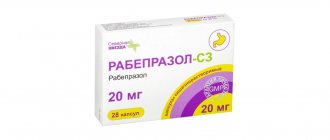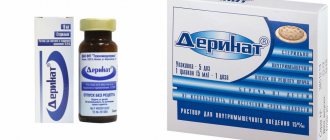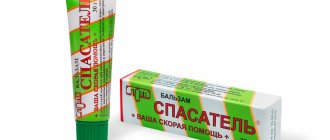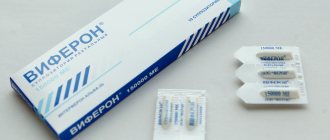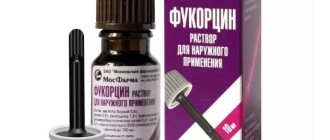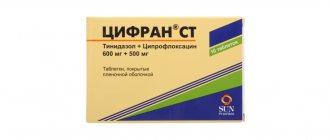With gastritis, ulcers and other lesions of the stomach, increased secretion of hydrochloric acid is observed - the main component of gastric juice. The result is ulcers, pain, digestive disorders and other consequences. Various medications are used to prevent it, including Rabeprazole. This is an effective remedy at an affordable price.
"Rabeprazole" composition and description
The drug is available in the form of capsules, which dissolve when entering the intestines. The active ingredient is rabeprazole sodium (10 or 20 mg in each capsule). The drug has an antiulcer effect.
It affects enzymes that are synthesized by the parietal cells of the stomach. As a result, hydrochloric acid is partially blocked, which reduces the secretion of gastric juice even with food intake. The active substance is completely absorbed within 3-4 hours. Moreover, the bioavailability of the drug does not depend on what time the capsules are taken.
The product should be stored under normal room conditions, away from direct sunlight. Access for children is excluded. The general shelf life is 2 years from the date of production.
Rabeprazole-SZ 10 mg
Registration number
LP-003466
Dosage form
enteric capsules
Compound
1 capsule contains:
active substance:
rabeprazole pellets – 118 mg
in terms of rabeprazole sodium – 10 mg
[pellet core: Rabeprazole sodium – 10.00 mg, granulated sugar (sucrose, starch molasses) – 71.47 mg, sodium carbonate – 1.65 mg, talc – 1.77 mg, titanium dioxide – 0.83 mg, hypromellose (hydroxymethylcellulose) – 14.75 mg;
pellet shell: hypromellose phthalate (hydroxypropyl methyl cellulose phthalate) – 15.93 mg, cetyl alcohol – 1.60 mg]
Excipients:
Hard gelatin capsules No. 3
Body: titanium dioxide – 2.0%, gelatin – up to 100%
Cap: azorubine dye (carmazine dye) – 0.6619%, indigo carmine – 0.0286%, titanium dioxide – 0.6666%, gelatin – up to 100%
Description
Hard gelatin capsules No. 3, white body with a dark red cap. The contents of the capsules are spherical pellets from almost white to white with a creamy or yellowish tint.
ATX code
[A02BC04]
Pharmacological properties
Pharmacodynamics
Mechanism of action
Rabeprazole sodium belongs to the class of antisecretory substances, benzimidazole derivatives. Suppresses the secretion of gastric juice by specifically inhibiting H+/K+-ATPase on the secretory surface of gastric parietal cells. H+/K+-ATPase is a protein complex that functions as a proton pump, so rabeprazole sodium is an inhibitor of the proton pump in the stomach and blocks the final stage of acid production. This effect is dose-dependent and leads to suppression of both basal and stimulated acid secretion, regardless of the stimulus.
Rabeprazole sodium does not have anticholinergic properties.
Antisecretory action
After oral administration of 20 mg of rabeprazole sodium, the antisecretory effect develops within an hour. Inhibition of basal and stimulated acid secretion 23 hours after taking the first dose of rabeprazole sodium is 69% and 82%, respectively, and lasts up to 48 hours. This duration of pharmacodynamic action far exceeds that predicted by the half-life (approximately one hour). This effect can be explained by the prolonged binding of the drug to the H+/K+-ATPase of gastric parietal cells. The magnitude of the inhibitory effect of rabeprazole sodium on acid secretion reaches a plateau after three days of taking rabeprazole sodium. When you stop taking it, secretory activity is restored within 1-2 days.
Effect on plasma gastrin levels
In clinical studies, patients took 10 or 20 mg of rabeprazole sodium daily for treatment durations of up to 43 months. Plasma gastrin levels were elevated in the first 2–8 weeks, reflecting an inhibitory effect on acid secretion. Gastrin concentrations returned to baseline levels usually within 1-2 weeks after cessation of treatment.
Effect on enterochromaffin-like cells
In a study of human gastric biopsy specimens from the antrum and fundus of the stomach of 500 patients treated with rabeprazole sodium or a comparator for 8 weeks, persistent changes in the morphological structure of enterochromaffin-like cells, severity of gastritis, incidence of atrophic gastritis, intestinal metaplasia, or prevalence of Helicobacter infection pylori were not detected.
In a study of more than 400 patients treated with rabeprazole sodium (10 mg/day or 20 mg/day) for up to 1 year, the incidence of hyperplasia was low and comparable to that of omeprazole (20 mg/kg). There have been no reported cases of adenomatous changes or carcinoid tumors observed in rats.
Other effects
Systemic effects of rabeprazole sodium on the central nervous system, cardiovascular or respiratory systems have not currently been detected. It has been shown that rabeprazole sodium, when taken orally at a dose of 20 mg for 2 weeks, does not affect the function of the thyroid gland, carbohydrate metabolism, the level of parathyroid hormone in the blood, as well as the levels of cortisol, estrogens, testosterone, prolactin, glucagon, follicle-stimulating hormone (FSH), luteinizing hormone (LH), renin, aldosterone and growth hormone.
Pharmacokinetics
Absorption
Rabeprazole is rapidly absorbed from the intestine and peak plasma concentrations are achieved approximately 3.5 hours after a 20 mg dose. Changes in peak plasma concentrations (Cmax) and area under the concentration-time curve (AUC) of rabeprazole are linear in the dose range from 10 to 40 mg. Absolute bioavailability after oral administration of 20 mg (compared to intravenous administration) is approximately 52%. In addition, bioavailability does not change with repeated dosing of rabeprazole. In healthy volunteers, the plasma half-life is approximately 1 hour (ranging from 0.7 to 1.5 hours) and the total clearance is 3.8 ml/min/kg. In patients with chronic liver damage, the AUC is doubled compared to healthy volunteers, indicating a decrease in first-pass metabolism, and the plasma half-life is increased by 2 to 3 times. Neither the time of taking the drug during the day nor antacids affect the absorption of rabeprazole. Taking the drug with fatty foods slows down the absorption of rabeprazole by 4 hours or more, but neither Cmax nor the degree of absorption changes.
Distribution
In humans, the degree of binding of rabeprazole to plasma proteins is about 97%.
Metabolism and excretion
In healthy people
After taking a single oral dose of 20 mg of 14C-labeled rabeprazole sodium, no unchanged drug was found in the urine. About 90% of rabeprazole is excreted in the urine mainly in the form of two metabolites: a conjugate of mercapturic acid (M5) and carboxylic acid (M6), as well as in the form of two unknown metabolites identified during toxicological analysis.
The remainder of the rabeprazole taken is excreted in the feces.
The total elimination is 99.8%. These data indicate a small excretion of rabeprazole metabolites in bile. The main metabolite is thioester (M1). The only active metabolite is desmethyl (M3), but this was observed at low concentrations in only one study participant after taking 80 mg rabeprazole.
End stage renal failure
In patients with stable end-stage renal disease who require maintenance hemodialysis (creatinine clearance <5 ml/min/1.73 m2), the elimination of rabeprazole is similar to that of healthy volunteers. AUC and Cmax in these patients were approximately 35% lower than in healthy volunteers. The average half-life of rabeprazole was 0.82 hours in healthy volunteers, 0.95 hours in patients undergoing hemodialysis, and 3.6 hours after hemodialysis. Clearance of the drug in patients with kidney disease requiring hemodialysis was approximately twice as high as in healthy volunteers.
Chronic compensated cirrhosis
Patients with chronic compensated liver cirrhosis tolerate rabeprazole 20 mg once daily, although AUC is doubled and Cmax is increased by 50% compared to sex-matched healthy volunteers.
Elderly patients
In elderly patients, the elimination of rabeprazole is somewhat slower. After 7 days of taking rabeprazole 20 mg per day in elderly patients, AUC was approximately twice as high and Cmax was increased by 60% compared to young healthy volunteers. However, there were no signs of accumulation of rabeprazole.
CYP2C19 polymorphism
In patients with slow metabolism of CYP2C19, after 7 days of taking rabeprazole at a dose of 20 mg per day, AUC increases by 1.9 times, and the half-life increases by 1.6 times compared with the same parameters in “rapid metabolizers,” while Cmax increases by 40%.
Indications for use
Symptoms of dyspepsia associated with increased acidity of gastric juice, incl. symptoms of gastroesophageal reflux disease (heartburn, sour belching).
Contraindications
- hypersensitivity to rabeprazole, substituted benzimidazoles or to the auxiliary components of the drug;
- sucrase/isomaltase deficiency, fructose intolerance, glucose-galactose deficiency;
- pregnancy;
- breastfeeding period;
- children under 18 years of age.
Carefully
- severe renal failure;
- severe liver failure.
Use during pregnancy and breastfeeding
There are no data on the safety of rabeprazole during pregnancy.
Reproduction studies in rats and rabbits showed no evidence of impaired fertility or fetal developmental defects associated with rabeprazole; however, in rats the drug crosses the placental barrier in small quantities. Rabeprazole-SZ should not be used during pregnancy.
It is not known whether rabeprazole is excreted in breast milk.
Appropriate studies on the use of the drug during breastfeeding have not been conducted.
However, rabeprazole was found in the milk of lactating rats, and therefore Rabeprazole-SZ should not be used by women during breastfeeding.
Directions for use and doses
Orally, at a dose of 10 mg once a day.
Rabeprazole-SZ capsules should be swallowed whole. It is recommended to take the drug in the morning, before meals. It has been established that neither time of day nor food intake affects the activity of rabeprazole sodium, but the recommended time of taking Rabeprazole-SZ capsules contributes to better patient compliance with the treatment regimen.
If there is no effect during the first three days of treatment, examination by a specialist is necessary. The maximum course of treatment without consulting a doctor is 14 days.
Side effect
Based on the experience of clinical studies, we can conclude that the drug Rabeprazole-SZ is usually well tolerated by patients. Side effects, generally mild or moderate, are transient.
During clinical studies, the following adverse reactions were observed when taking rabeprazole: headache, abdominal pain, diarrhea, flatulence, constipation, dry mouth, dizziness, rash, peripheral edema.
Adverse reactions are systematized in accordance with the WHO Classification:
Very common (≥ 1/10);
Often (≥ 1/100, < 1/10);
Uncommon (≥ 1/1000, < 1/100);
Rarely (≥ 1/10000, < 1/1000);
Very rare (<1/10000), including isolated cases;
Frequency unknown (cannot be determined from available data).
Disorders of the blood and lymphatic system: rarely - thrombocytopenia, neutropenia, leukopenia;
Immune system disorders: rarely - acute systemic allergic reactions;
Metabolic and nutritional disorders: rarely – hypomagnesemia;
Disorders of the liver and biliary tract: increased activity of liver enzymes, rarely - hepatitis, jaundice, hepatic encephalopathy;
Disorders of the skin and subcutaneous tissues: rarely - bullous rashes, urticaria; very rarely - erythema multiforme, toxic epidermal necrolysis, Stevens-Johnson syndrome;
Musculoskeletal and connective tissue disorders: rarely – myalgia, arthralgia;
Renal and urinary tract disorders: very rarely – interstitial nephritis;
Disorders of the genital organs and breast: very rarely - gynecomastia.
No changes in other laboratory parameters were observed while taking rabeprazole sodium.
According to post-marketing observations, when taking proton pump inhibitors (PPIs), there may be an increased risk of fractures, subacute cutaneous lupus erythematosus and glandular polyps of the fundus of the stomach (see section "Special Instructions"). Rare reports of hepatic encephalopathy have been reported in patients with cirrhosis.
Overdose
Symptoms
Data on intentional or accidental overdose are minimal. There have been no cases of severe overdose of rabeprazole.
Treatment
A specific antidote for rabeprazole is unknown. Rabeprazole binds well to plasma proteins and is therefore poorly excreted during dialysis. In case of overdose, symptomatic and supportive treatment should be provided.
Interaction with other drugs
Cytochrome 450 system
Rabeprazole sodium, like other proton pump inhibitors (PPIs), is metabolized by the cytochrome P450 (CYP450) system in the liver. In vitro studies on human liver microsomes have shown that rabeprazole sodium is metabolized by isoenzymes CYP2C19 and CYP3A4.
Studies in healthy volunteers have shown that rabeprazole sodium has no pharmacokinetic or clinically significant interactions with drugs that are metabolized by the cytochrome P450 system - warfarin, phenytoin, theophylline and diazepam (regardless of whether patients metabolize diazepam extensively or poorly).
A study of combination therapy with antibacterial drugs was conducted. This four-way crossover study involved 16 healthy volunteers who received rabeprazole 20 mg, amoxicillin 1000 mg, clarithromycin 500 mg, or a combination of these three drugs (RAC - rabeprazole, amoxicillin, clarithromycin). AUC and Cmax values for clarithromycin and amoxicillin were similar when combination therapy was compared with monotherapy. AUC and Cmax for rabeprazole increased by 11% and 34%, respectively, and for 14-hydroxyclarithromycin (the active metabolite of clarithromycin), AUC and Cmax increased by 42% and 46%, respectively, for combination therapy compared with monotherapy. This increase in exposure rates for rabeprazole and clarithromycin was not considered clinically significant.
Interactions due to inhibition of gastric acid secretion
Rabeprazole sodium provides a stable and long-lasting suppression of gastric acid secretion. Thus, interactions may occur with substances for which absorption is pH dependent. When taken simultaneously with rabeprazole sodium, the absorption of ketoconazole is reduced by 30%, and the absorption of digoxin is increased by 22%. Therefore, some patients should be monitored to determine whether dose adjustments are necessary when taking rabeprazole sodium concomitantly with ketoconazole, digoxin, or other drugs for which absorption is pH dependent.
Atazanavir
When atazanavir 300 mg/ritonavir 100 mg was coadministered with omeprazole (40 mg once daily) or atazanavir 400 mg with lansoprazole (60 mg once daily) in healthy volunteers, a significant reduction in atazanavir exposure was observed. Absorption of atazanavir is pH dependent. Although concomitant use with rabeprazole has not been studied, similar results are expected for other proton pump inhibitors. Therefore, concomitant use of atazanavir with proton pump inhibitors, including rabeprazole, is not recommended.
Antacids
In clinical studies, antacid substances were used in conjunction with rabeprazole sodium. Clinically significant interactions of rabeprazole sodium with aluminum hydroxide gel or magnesium hydroxide were not observed.
Eating
In a clinical study, no clinically significant interactions were observed when rabeprazole sodium was taken with a low-fat meal. Taking rabeprazole sodium simultaneously with a fat-enriched meal may slow down the absorption of rabeprazole by up to 4 hours or more, however, Cmax and AUC do not change.
Cyclosporine
In vitro experiments using human liver microsomes showed that rabeprazole inhibits the metabolism of cyclosporine with an IC50 of 62 µM, i.e. at a concentration 50 times higher than the Cmax for healthy volunteers after 14 days of taking 20 mg rabeprazole. The degree of inhibition is similar to that of omeprazole for equivalent concentrations.
Methotrexate
Adverse event reports, published pharmacokinetic studies, and retrospective analyzes suggest that concomitant use of PPIs and methotrexate (primarily at high doses) may result in increased concentrations of methotrexate and/or its metabolite hydroxymethotrexate and prolong the elimination half-life. However, no specific drug interaction studies have been conducted between methotrexate and PPIs.
Impact on laboratory results
The use of PPIs leads to a decrease in gastric acidity, which can lead to an increase in chromogranin A (CgA) in the blood serum. Elevated CgA levels may lead to misinterpretation of laboratory results for the presence of a neuroendocrine tumor. To avoid this effect, use of Rabeprazole-SZ should be temporarily discontinued at least 14 days before assessing CgA levels; repeating the test should be considered if the initial CgA level is high.
special instructions
The patient's response to rabeprazole therapy does not exclude the presence of malignant neoplasms in the stomach.
Rabeprazole-SZ capsules should be swallowed whole. It has been established that neither time of day nor food intake affects the activity of rabeprazole sodium.
In a special study in patients with mild or moderate liver dysfunction, there was no significant difference in the incidence of side effects of rabeprazole sodium from that of healthy individuals matched by sex and age, but despite this, caution is recommended when first prescribing Rabeprazole-SZ to patients with severe liver dysfunction. The AUC of rabeprazole sodium in patients with severe hepatic impairment is approximately two times higher than in healthy patients.
For patients with impaired renal or liver function, dose adjustment of Rabeprazole-SZ is not required.
Hypomagnesemia
Rare cases of symptomatic or asymptomatic hypomagnesemia have been reported when treated with PPIs for at least 3 months. In most cases, these reports were received one year after therapy. Serious adverse events included tetany, arrhythmia, and seizures. Most patients required treatment for hypomagnesemia, including magnesium replacement and discontinuation of PPI therapy. In patients who will be receiving long-term treatment or who are taking PPIs with drugs such as digoxin or drugs that can cause hypomagnesemia (eg, diuretics), health care providers should monitor magnesium levels before initiating PPI treatment and during treatment.
Patients should not take other acid-reducing agents, such as H2 receptor blockers or proton pump inhibitors, at the same time as Rabeprazole-SZ.
Bone fractures
Observational studies suggest that proton pump inhibitor (PPI) therapy may increase the risk of osteoporosis-related fractures of the hip, wrist, or spine. The risk of fractures was increased in patients receiving high doses of PPIs for a long time (a year or more).
Concomitant use of rabeprazole with methotrexate
According to the literature, simultaneous use of PPIs with methotrexate (primarily in high doses) can lead to increased concentrations of methotrexate and/or its metabolite hydroxymethotrexate and increase the half-life, which can lead to methotrexate toxicity. If high doses of methotrexate are required, temporary discontinuation of PPI therapy may be considered.
Clostridium difficile.
PPI therapy may lead to an increased risk of gastrointestinal infections such as Clostridium difficile.
Subacute cutaneous lupus erythematosus (SCLE)
There are reports of cases of PCLE during PPI therapy. If skin lesions appear, especially on areas of skin exposed to direct sunlight, and are accompanied by arthralgia, the patient should immediately seek medical attention and the health care professional should decide to discontinue rabeprazole therapy. The occurrence of PCLE with previous PPI therapy may increase the risk of PCLE with other PPIs.
Glandular polyps of the fundus of the stomach
Long-term use of PPIs, including rabeprazole, appears to be associated with an increased risk of fundal glandular polyps. Most glandular polyps of the fundus of the stomach are asymptomatic. Patients with large or ulcerated polyps may be at risk for gastrointestinal bleeding or small bowel obstruction. The dosage and duration of PPI therapy for such patients should be kept to a minimum.
Patients taking Rabeprazole-SZ for short-term symptomatic treatment of manifestations of GERD and NERD (for example, heartburn) without a prescription should consult a doctor in the following cases:
- using medications to relieve symptoms of heartburn and indigestion for 4 weeks or more,
- the appearance of new symptoms or a change in previously observed symptoms in patients over 55 years of age,
- cases of unintentional weight loss, anemia, bleeding in the gastrointestinal tract, dysphagia, pain when swallowing, persistent vomiting or vomiting with blood and epigastric contents, cases of stomach ulcers or a history of gastric surgery, jaundice, etc. (including impaired liver and kidney function).
Patients suffering from recurring symptoms of indigestion or heartburn for a long time should be monitored regularly by a doctor. Patients over 55 years of age who take over-the-counter medications daily to relieve symptoms of heartburn and indigestion should tell their healthcare provider.
Patients should not take other acid-reducing agents, such as H2 receptor blockers or proton pump inhibitors, at the same time as Rabeprazole-SZ.
If using other medications, patients should consult their pharmacist or healthcare provider before starting therapy with the over-the-counter Rabeprazole-SZ drug.
Patients should inform their physician before using Rabeprazole-SZ without a prescription if they are scheduled for an endoscopic examination.
Avoid taking Rabeprazole-SZ before performing a urea breath test.
Patients with severe hepatic impairment should consult a physician before initiating over-the-counter Rabeprazole-SZ therapy for short-term symptomatic treatment of manifestations of GERD and NERD (eg, heartburn).
Impact on the ability to drive vehicles and operate machinery
Based on the pharmacodynamics of rabeprazole sodium and its profile of undesirable effects, it is unlikely that Rabeprazole-SZ affects the ability to drive vehicles and operate machinery. However, if drowsiness occurs, these activities should be avoided.
Release form
Enteric capsules 10 mg.
10 or 14 capsules per blister pack.
30, 60 or 100 capsules per polymer jar or polymer bottle.
Each jar or bottle, 2, 3, 6 blister packs of 10 capsules each, 1, 2, 4 blister packs of 14 capsules, together with instructions for use, are placed in a cardboard box.
Best before date
3 years.
Do not use after the expiration date stated on the package.
Storage conditions
In a place protected from light, at a temperature not exceeding 25 ° C.
Vacation conditions
Available without a prescription.
Prescription drug
Over-the-counter drug
Indications for use
The drug has antiulcer activity. It is prescribed in the presence of such pathologies:
- stomach ulcer;
- ulcerative lesions of the duodenum (also during an exacerbation);
- increased secretion of gastric shock;
- Zollinger-Ellison syndrome;
- gastritis of various types, including chronic (in this case, antibacterial drugs are taken simultaneously);
- relapses of peptic ulcer associated with the action of the bacterium Helicobacter pylori;
- reflux disease of the gastroesophageal type.
Khairabezol (Rabeprazole) TB po intestinal 20 mg N 30
Release form, composition and packaging
Tablets, enteric film-coated from light pink to reddish-pink, round, biconvex; On a cross section, the kernel is white or white with a yellowish tint.
| 1 tab. | |
| rabeprazole sodium | 10 mg |
Excipients: magnesium oxide - 50 mg, mannitol - 17.5 mg, corn starch - 2.5 mg, povidone K30 - 1.5 mg, low-substituted hyprolose - 16 mg, sodium stearyl fumarate - 2 mg.
Shell composition: cellacephate - 11.25 mg, titanium dioxide - 1 mg, red iron oxide dye - 0.1 mg.
Tablets, enteric film coated, light yellow to yellow, round, biconvex; On a cross section, the kernel is white or white with a yellowish tint.
| 1 tab. | |
| rabeprazole sodium | 20 mg |
Excipients: magnesium oxide - 69 mg, mannitol - 40 mg, corn starch - 2.5 mg, povidone K30 - 1.5 mg, low-substituted hyprolose - 24 mg, sodium stearyl fumarate - 2 mg.
Shell composition: cellacephate - 18 mg, titanium dioxide - 1.6 mg, yellow iron oxide dye - 0.16 mg.
Clinical and pharmacological group:
H+-K+-ATPase inhibitor. Antiulcer drug
Pharmacotherapeutic group:
Proton pump inhibitor
pharmachologic effect
An antiulcer drug from the group of proton pump inhibitors (H+/K+-ATPase), is metabolized in the parietal cells of the stomach to active sulfonamide derivatives, which inactivate the sulfhydryl groups of H+/K+-ATPase.
Blocks the final stage of hydrochloric acid secretion, reducing the content of basal and stimulated secretion, regardless of the nature of the stimulus.
It is highly lipophilic, easily penetrates into the parietal cells of the stomach and concentrates in them, exerting a cytoprotective effect.
The antisecretory effect after oral administration of 20 mg occurs within 1 hour and reaches a maximum after 2-4 hours; inhibition of basal and food-stimulated acid secretion 23 hours after the first dose is 62% and 82%, respectively; duration of action - 48 hours. After the end of administration, secretory activity normalizes within 2-3 days.
In the first 2-8 weeks of therapy, the concentration of gastrin in the blood serum increases and returns to initial levels within 1-2 weeks after discontinuation of the drug. Does not affect the central nervous system, cardiovascular and respiratory systems.
Pharmacokinetics
Suction and distribution
Absorbed from the small intestine (due to the presence of an acid-resistant enteric coating). Absorption is high, time to reach Cmax is 3.5 hours. Cmax and AUC values are linear in the dose range from 10 to 40 mg. Bioavailability - 52%, does not increase with repeated doses.
Communication with plasma proteins - 97%.
Metabolism and excretion
Metabolized in the liver with the participation of cytochrome P450 isoenzymes (CYP 2C19 and CYP 3A4).
T1/2 - 0.7-1.5 hours, clearance - 283 ± 98 ml/min. Excreted by the kidneys - 90% in the form of two metabolites: a conjugate of mercapturic acid (M5) and carboxylic acid (M6); intestines - 10%.
Pharmacokinetics in special clinical situations
In patients with mild or moderate chronic liver failure, after a single dose, AUC increases by 2 times, T1/2 by 2-3 times. After taking 20 mg of rabeprazole for 7 days, AUC increases by 1.5 times, T1/2 - by 1.2 times. In patients with stable end-stage renal failure requiring hemodialysis (creatinine clearance less than 5 ml/min/1.73 m2), the distribution of rabeprazole sodium is close to that in healthy individuals.
In elderly patients, after taking rabeprazole for 7 days, AUC is 2 times greater, Cmax is 60% greater than in young patients.
In patients with slow metabolism of CYP2C19, after 7 days of taking rabeprazole at a dose of 20 mg per day, AUC increases by 1.9 times, and T1/2 by 1.6 times compared with the same parameters in “rapid metabolizers,” while Cmax increases by 40 %.
Indications
- peptic ulcer of the stomach and duodenum in the acute stage;
- gastroesophageal reflux disease;
- hypersecretory conditions, including Zollinger-Ellison syndrome;
- stress ulcers of the gastrointestinal tract.
As part of complex therapy:
— eradication of Helicobacter pylori in patients with gastric and duodenal ulcers or chronic gastritis;
- treatment and prevention of relapse of peptic ulcer associated with Helicobacter pylori.
Dosage regimen
The drug is prescribed 20 mg 1 time/day. The tablets should be taken orally, in the morning before meals, swallowed whole, without chewing or crushing.
For duodenal ulcer and gastric ulcer in the acute stage, 20 mg (1 tablet) is prescribed 1 time per day in the morning for 4-6 weeks.
For gastroesophageal reflux disease (GERD), 20 mg (1 tablet) is prescribed 1 time/day for 4-8 weeks.
For maintenance therapy for GERD - at a dose of 10 or 20 mg 1 time / day, depending on the patient’s response.
For the symptomatic treatment of GERD in patients without esophagitis - at a dose of 10 mg 1 time / day for 4 weeks.
For the treatment of Zollinger-Ellison syndrome and other conditions characterized by pathological hypersecretion, the dose is selected individually.
For the treatment of duodenal ulcer or chronic gastritis associated with Helicobacter pylori infection, a 7-day course of treatment with one of the following combinations of drugs is recommended:
Khairabezole 20 mg 2 times/day + clarithromycin 500 mg 2 times/day and amoxicillin 1 g 2 times/day.
Hairabezole 20 mg 2 times/day + clarithromycin 500 mg 2 times/day and metronidazole 400 mg 2 times/day.
Side effect
WHO classification of unwanted adverse reactions by frequency of development: very often - 1/10 prescriptions (≥ 10%), often - 1/100 prescriptions (≥ 1%, but < 10%), infrequently - 1/1000 prescriptions (≥ 0.1%, but < 1%), rarely - 1/10,000 prescriptions (≥ 0.01%, but < 0.1%), very rarely - less than 1/10,000 prescriptions (< 0.01%).
From the digestive system: often - diarrhea, nausea; uncommon - vomiting, abdominal pain, flatulence, constipation; rarely - dry mouth, belching, dyspepsia; very rarely - impaired taste, anorexia, stomatitis, gastritis, increased transaminase activity.
From the nervous system and sensory organs: often - headache; rarely - dizziness, asthenia, insomnia; very rarely - nervousness, drowsiness, depression, visual disturbances, taste disturbances.
From the musculoskeletal system: rarely - myalgia; very rarely - arthralgia, cramps of the calf muscles.
From the respiratory system: rarely - inflammation or infection of the upper respiratory tract, severe cough; very rarely - sinusitis, bronchitis.
From the hematopoietic organs and hemostasis system: rarely - thrombocytopenia, leukopenia; very rarely - leukocytosis.
Allergic reactions: rarely - rash, itching.
Other: rarely - pain in the back, chest, limbs, swelling, urinary tract infection, fever, chills, flu-like syndrome; very rarely - increased sweating, weight gain.
Contraindications for use
- pregnancy;
- breast-feeding;
- children and adolescents up to 18 years of age;
- hypersensitivity to rabeprazole, benzimidazoles or other components of the drug.
The drug should be prescribed with caution in cases of severe liver failure and severe renal failure.
Use during pregnancy and breastfeeding
Rabeprazole should not be prescribed during pregnancy (there are no data on the safety of rabeprazole during pregnancy).
It is not known whether rabeprazole is excreted in breast milk. Appropriate studies have not been conducted in lactating women. Breastfeeding should be stopped during treatment.
Use for liver dysfunction
The drug should be prescribed with caution in severe liver failure.
In patients with impaired liver function, no dose adjustment is required.
Use for renal impairment
The drug should be prescribed with caution in severe renal failure.
Patients with impaired renal function do not require dose adjustment.
Use in children
The drug is not recommended for use in children, since there is no experience with the use of rabeprazole in pediatric practice.
Use in elderly patients
In elderly patients, after taking rabeprazole for 7 days, AUC is 2 times greater, Cmax is 60% greater than in young patients.
special instructions
Before and after treatment with rabeprazole, endoscopic monitoring is required to exclude malignancy, because treatment may mask symptoms and delay correct diagnosis.
Caution is recommended when first prescribing rabeprazole to patients with severely impaired liver function.
The drug does not affect the function of the thyroid gland, carbohydrate metabolism, the blood concentration of parathyroid hormone, cortisol, estrogen, testosterone, prolactin, cholecystokinin, secretin, glucagon, follicle-stimulating hormone, luteinizing hormone, renin, aldosterone and somatotropic hormone.
Patients with impaired renal or liver function do not require dose adjustment.
Withdrawal of the drug is not accompanied by the rebound phenomenon; the restoration of secretory activity occurs within 2-3 days as new enzyme molecules are synthesized.
Use in pediatrics
The drug is not recommended for use in children and adolescents, since there is no experience with the use of rabeprazole in pediatric practice.
Impact on the ability to drive vehicles and operate machinery
If drowsiness occurs during treatment, you should stop driving and other activities that require increased concentration and speed of psychomotor reactions.
Overdose
Symptoms: not described.
Treatment: if an overdose is suspected, supportive and symptomatic therapy is recommended. Dialysis is ineffective.
Drug interactions
Rabeprazole slows down the excretion of certain drugs metabolized in the liver by microsomal oxidation (diazepam, phenytoin, indirect anticoagulants).
Reduces the concentration of ketoconazole by 33%, digoxin by 22%.
Does not interact with liquid antacids.
Compatible with drugs metabolized by the CYP 450 system (warfarin, phenytoin, theophylline, diazepam).
Conditions for dispensing from pharmacies
The drug is available with a prescription.
Contraindications and side effects
In some cases, taking the drug is excluded:
- hypersensitivity to the active ingredient;
- pregnancy period;
- breastfeeding period.
When taking the drug, side effects may occur from both the digestive system and other systems:
- loss of appetite;
- flatulence;
- constipation;
- nausea, vomiting;
- diarrhea;
- headaches;
- dizziness;
- drowsiness;
- taste disturbances;
- stomatitis;
- visual impairment;
- myalgia;
- pain in the spine;
- feverish condition;
- convulsions;
- arthralgia;
- allergic reactions (rash);
- cough;
- sinusitis;
- runny nose.
If the described phenomena occur, the drug should be stopped. Consultation with a doctor and symptomatic treatment are indicated.
Instructions for use "Rabeprazole"
The drug is taken orally with water. The initial dosage is from 10 to 20 mg of the active substance, which corresponds to 1-2 capsules. The total amount and duration of the course depend on the nature of the disease. The appointment is carried out on the recommendation of a doctor. No cases of overdose have been reported to date.
Important!
In childhood, taking the drug is not recommended, since relevant studies on the effect of the drug on health have not been conducted.
Drug interactions
The active substance rabeprazole sodium does not interact with antacids, so it is allowed to be taken together with drugs such as Rennie, Almagel, Phosalugel, etc.
At the same time, rabeprazole can increase the concentration in the blood of substances such as digoxin and ketoconazole. This is important to consider when taking medications with these active ingredients.
Rabeprazole can be taken together with medications such as Theophylline, Phenytonin, Warfarin and Diazepam. The simultaneous use of Pantoprazole is possible.
Rabeprazole PSK
Drugs metabolized via cytochrome CYP450 isoenzymes
Rabeprazole sodium, like other proton pump inhibitors (PPIs), is metabolized by the cytochrome P450 (CYP450) system in the liver. in vitro studies
Using human liver microsomes, it was shown that rabeprazole sodium is metabolized by the isoenzymes CYP2C19 and CYP3A4.
Studies in healthy volunteers have shown that rabeprazole sodium has no pharmacokinetic or clinically significant interactions with drugs that are metabolized by the cytochrome P450 system - warfarin, phenytoin, theophylline and diazepam (regardless of whether patients metabolize diazepam extensively or poorly).
Warfarin
There are reports of prolongation of the international normalized ratio (INR) and prothrombin time (PT) in patients receiving concomitant proton pump inhibitors, including rabeprazole, and warfarin. Prolongation of INR and PT may lead to an increased risk of bleeding.
Cyclosporine
in vitro studies
with human liver microsomes, it was shown that rabeprazole inhibits the metabolism of cyclosporine with an inhibitory concentration of 50-62 μmol, which is more than 50 times higher than the maximum concentration in healthy volunteers after administration of 20.0 mg rabeprazole. This degree of inhibition was similar to that of omeprazole at equivalent concentrations.
Medicines whose absorption depends on gastric pH
Rabeprazole sodium provides a stable and long-lasting suppression of gastric acid secretion. Thus, interactions may occur with substances for which absorption is pH dependent. When taken simultaneously with rabeprazole sodium, the absorption of ketoconazole is reduced by 30%, and the absorption of digoxin is increased by 22%. Therefore, some patients should be monitored to determine whether dose adjustments are necessary when taking rabeprazole sodium concomitantly with ketoconazole, digoxin, or other drugs for which absorption is pH dependent.
Concomitant use of rabeprazole and antacids
does not lead to clinically significant changes in plasma concentrations of rabeprazole.
With simultaneous use of atazanavir
with proton pump inhibitors, a significant decrease in the concentration of atazanavir is expected, which leads to a decrease in its therapeutic effect, therefore the simultaneous use of atazanavir with proton pump inhibitors (including rabeprazole) is not recommended.
With simultaneous use of rabeprazole, amoxicillin and clarithromycin, the AUC and Cmax values for clarithromycin and amoxicillin were similar when comparing combination therapy with monotherapy. The AUC and Cmax of rabeprazole increased by 11% and 34%, respectively, and the AUC and Cmax of 14-hydroxyclarithromycin (the active metabolite of clarithromycin) increased by 42% and 46%, respectively. This increase in indicators was not considered clinically significant.
Methotrexate
Based on reports of adverse events, published pharmacokinetic studies and retrospective analysis, it can be assumed that the simultaneous use of proton pump inhibitors and methotrexate (primarily in high doses) may lead to increased concentrations of methotrexate and/or its metabolite hydroxy methotrexate and prolong the period half-life. However, no specific drug interaction studies have been conducted between methotrexate and proton pump inhibitors.
Medicines metabolized by the CYP2C19 isoenzyme
In a clinical study in Japan evaluating rabeprazole in patients according to CYP2C19 genotype (n=6 in each genotype category), acid suppression was greater in poor metabolizers than in extensive metabolizers, which may be due to higher rabeprazole concentrations in poor metabolizers. Differences between slow and extensive metabolizers in interactions with other drugs metabolized by CYP2C19 have not been studied.
special instructions
The course of treatment with Rabeprazole should begin with a check of the gastrointestinal tract. If malignant tumors are detected, you should not take the drug, since the medicine masks some of the symptoms of cancer. This can make them difficult to diagnose and treat because time will be lost.
The drug should be taken with caution in cases of diagnosed liver disease. If taken simultaneously with Digoxin and Ketonazole, the dosage of these drugs must be adjusted.
One of the possible side effects of Rabeprazole is increased fatigue and drowsiness. Therefore, drivers and operators of moving machinery should take the product with caution. During therapy, you may have to temporarily give up work that requires increased concentration.
